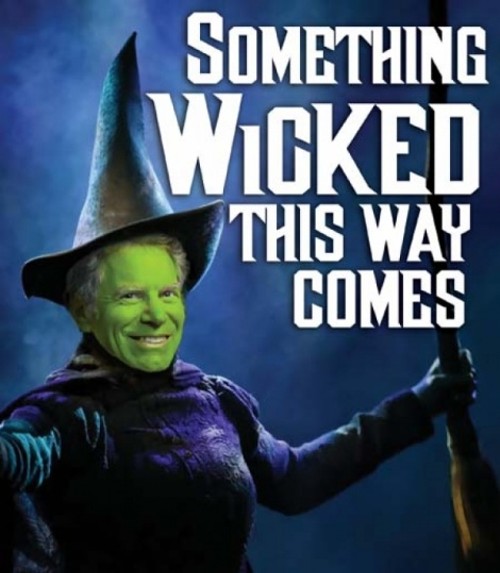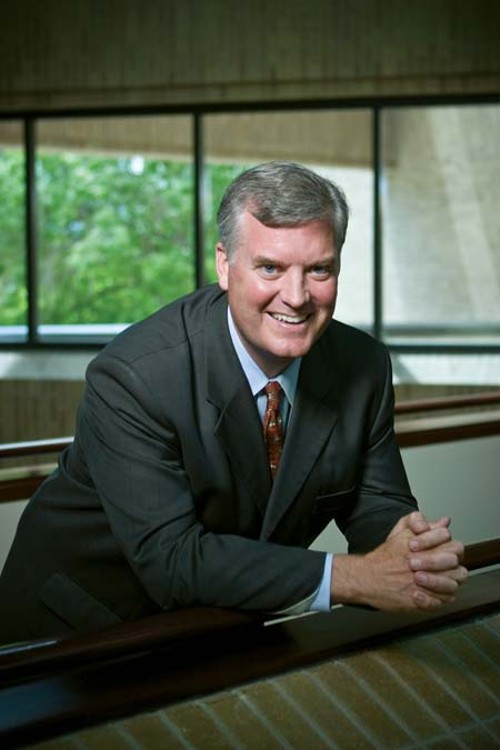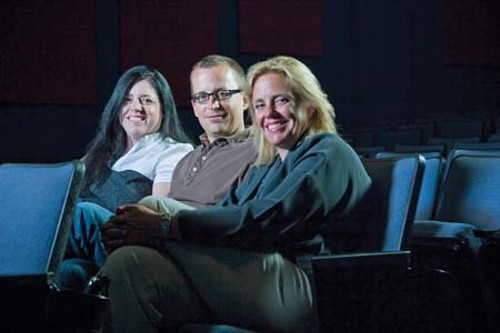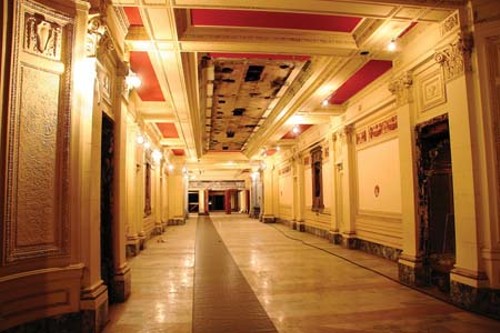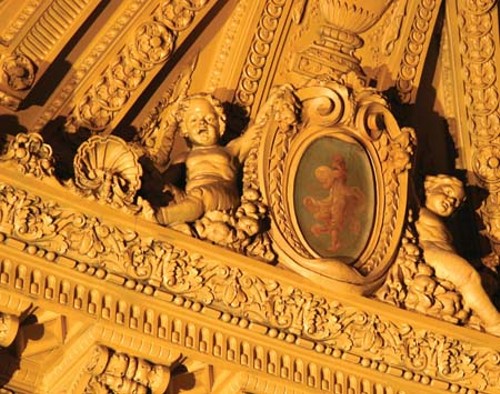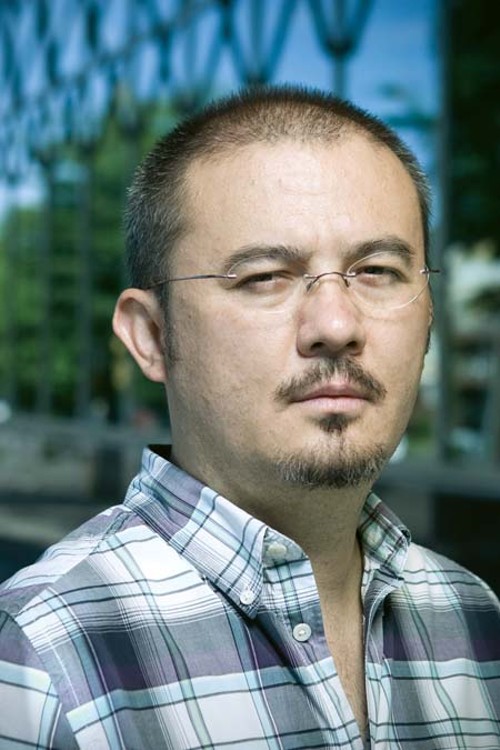Something Wicked This Way Comes
An arts district one block from Temple Square will either save Main Street or become its biggest folly yet.
By Geoff Griffin“I`m a basic philistine when it comes to the arts,” Ralph Becker says, when asked about his vision for a new Broadway theater on Main Street. “When I go around to other cities, I go to performance arts facilities and ask them questions.”
The Salt Lake City mayor´s personal shoe-leather research has given him a clear vision of what he wants downtown to look like in three years. He uses the word “vibrant.” He wants to see streets teeming with locals and visitors, all enjoying “a wide range of culture and entertainment.”
It’s the kind of stock answer you’d expect from a mayor of any city.
But, Becker is willing to be very specific about what he thinks will bring those people downtown. Most notably, Becker wants to build a performing arts center on Main Street between 100 and 200 South, in the old Newspaper Agency Corp. space—a 2,500-seat, stateof-the-art performance space offering first-run Broadway touring shows, pop and rock concerts, as well as performances by local groups such as Ballet West and Utah Opera.
And that’s not all. “Across the street,” Becker continues, “the renovated downtown historic jewel, the Utah Theater, is home to the new Utah Film & Media Arts Center, a cultural cornerstone on Main Street.”
Rob Eddington professes guarded enthusiasm for the project. As proprietor of Murphy’s Bar & Grill at 160 S. Main for the past 11 years, his establishment would be in the thick of things if the plans were to pan out. “I’m glad to see anything happening, even if it is just talk,” he says. “And so far, that’s all it is. But anything to revitalize this part of the downtown area is going to be welcome.”
“I want Salt Lake City to be a major-league town,” Becker insists, and he isn’t talking baseball.
It’s a tall order, and some aren’t so sure it can be achieved without exacting a price— particularly upon existing arts organizations and facilities that are limping along in the current economy. Additionally, the project will need to co-exist within a grand scheme in which the LDS Church exerts a stronger presence downtown through its City Creek project. Most have to ask if government-funded centers for performing arts and indie film will become an extension of Temple Square, or “Temple Sprawl” as some call it, complete with vanilla, family-friendly overtones? Or will a performing arts center breathe life, grit and passion back into downtown’s almost lifeless corpse?
"A major contributor"
No
matter what Becker or others may want for downtown, The Church of Jesus
Christ of Latterday Saints, with its world headquarters and temple
properties spreading across six city blocks, remains downtown’s
foremost landlord. As the proprietor of Utah’s No. 1 downtown tourist
attraction, the developer behind the emerging City Creek Center and the
potential seller of property that would be used for the performing-arts
center, the church has a tremendous interest in the future of a
downtown arts program. To that end, the church gave $100,000 to help
fund Salt Lake County’s study to create an arts master plan.
The
LDS Church declined to give an interview for this article but did
provide the following statement through spokesman Scott Trotter: “The
church is committed to the development of downtown Salt Lake and is in
a unique position to act as a major contributor, along with many
others, to a vibrant, high-quality downtown that will continue to be a
regional destination.”
Again, the word “vibrant.”
Those who walk around in the shadow of Temple Square on a daily basis
may forget that, for visitors, the temple is the international symbol
of Salt Lake City. Scott Beck, Salt Lake Convention and Visitors Bureau
CEO, notes, “There’s a reason why Temple Square is the most visited
location in Utah—it’s not anywhere else.”
And, as such, the church has a need to influence and mold the environment surrounding its cherished symbol. And shouldn’t the church, as “a major contributor” to the downtown area, expect to be part of any conversation regarding arts-center programming performed just two blocks away, especially in light of a recent Pew study that showed 68 percent of Mormons feel their values are often threatened by the entertainment industry?
For a downtown performing arts facility to be truly “vibrant,” it would
stage productions the church likely would frown upon its members
attending. For example, how well would a touring production of Avenue Q—the Broadway
hit that features Sesame Street-like characters discussing sex,
drinking and Internet porn—fare on any conference weekend?
“In all our discussions, [the church has] never mentioned content,” Salt Lake County Mayor Peter Corroon says. “They’ve never once broached the subject.”
Greg Geilmann, director of Kingsbury Hall, can speak to the church’s influence firsthand and says that censorship isn’t the issue. “I don’t think the LDS Church is in the business of shaping programming,” he says. “They’re in the business of telling their membership what to do,” he says, citing an example from a few years ago when the church allegedly got the message out to its membership not to attend a local run of the musical Chicago.
“I understand the Mormon/non-Mormon dynamics of this city as well as anybody,” Becker says. He emphasizes that the downtown arts scene should be a “bridge” between the two groups. He notes that the church’s sphere of influence generally ends around 100 South, especially after it sells the property on Main Street envisioned to be used as the arts facility. He also points out that the church will want to have successful properties surrounding City Creek.
“Their role is just as another member of the community,” Becker says of the church, before going on to add, “That doesn’t mean they don’t have an interest.”
Jason Mathis, executive director of the Downtown Alliance, says that different factors—including the LDS presence—give Salt Lake City a different dynamic than any other place, and that’s something to be emphasized rather than shied away from. “We need to be ourselves and not worry so much about what the rest of the world may think of us,” he says. “As we become more secure about ourselves, the rest of the world will take note.”
When asked if he thought the LDS Church headquarters in close proximity
of an entertainment district on his block would have a chilling effect,
Frody Volgger, owner and chef of the Vienna Bistro at 132 S. Main,
thinks it’s just the opposite: the church will bring more people
downtown, people with cosmopolitan tastes who will want entertainment
and amenities. Once the LDS Church sells its City Creek condos, he
predicts, “most of these people are going to be coming from out of
state, not instate. Those people have more insight about what is going
on around the world.
“Those condos—some of them are selling
for $2 million—are very high end. I think we’re going to get an influx
from other parts of the country and maybe even from the world.”
Wicked Economics
For
Becker’s downtown vision to take hold, he must first convince the local
arts community his grand idea won’t put them out of business.
“I
have been sensitive from the very beginning that we need to do this in
a way that serves the existing performing arts community and does not
detract from their ability to function,” Becker says.
But John Caywood, Kingsbury Hall operations manager, begs to differ, arguing if Becker’s performing arts center is built, and touring Broadway shows end up there rather than at Kingsbury, his facility could lose about $400,000 per year.
“For us, that’s the difference between operating in the black and operating in the red,” he says.
Furthermore,
some in the existing arts community wonder why there’s any need to
improve on what has come about organically. “I take exception to the
term ‘cultural district,’” says Jerry Rapier, producing director of
Plan-B Theater Company. “One already exists. The Rose Wagner, Capitol
Theatre and Abravanel Hall are all within a block of each other.”
Even
in terms of distance, some question if a downtown arts district needs
to be confined to a few city blocks. Chris Lino, managing director of
Pioneer Theatre Company at the University of Utah, notes that the
distance between Temple Square and Pioneer Theatre is less than the
distance between the northernmost and southernmost theaters on Broadway
in New York City, and is easily accessible by TRAX. “It’s 13 blocks,”
he says. “We’re not talking 20 miles away.”
The
question of the performing-arts center, in particular, and having the
government try to help push along a downtown arts scene in general,
seems to come down to economic philosophy. Some existing organizations
see the battle for arts dollars as a zero-sum game, with Becker’s
proposals merely creating more entities trying to get a share of the
same pie. Becker and other proponents of the center say the new
facility would help to grow the overall size of the arts pie, with
everyone still getting their share and the audience getting more
offerings.
Becker says he is “committed to not tapping existing arts revenue sources,” but also notes, “public arts facilities will always need to be subsidized by public funds.”
Charles
Morey, Pioneer Theatre Company artistic director, contends a downtown
performing arts center would end up “robbing from one to fill another.
Will there be more product? Yeah. Will the market sustain more product?
You already have major arts organizations teetering on the brink.”
Lino
notes the Wasatch Front has recently added facilities such as Rio Tinto
Stadium, where a recent concert by the Eagles failed to sell out. He
worries that projections about who will pay for entertainment can be
overblown. “The mania for building is already playing out, and it’s not
playing out the way the proponents said it would,” he says. Becker
thinks the center will help grow the overall arts market because it
will attract new folks to downtown Salt Lake City, people who normally
don’t have a reason to go there. It will also open up the entire arts
marketplace for people who might otherwise only seek out one aspect of
it. “There are people who go to Wicked, but not to the ballet,”
he says. “We need to draw those people into the performing arts.” He
also stresses that the center is more than just Broadway shows; it
would also include a variety of entertainment forms.
Scott Beck says the convention and visitors bureau takes a regional perspective when looking at what Salt Lake City can offer because, “people in Wyoming and Idaho see Salt Lake City as their place.” He further notes that Salt Lake City has grown to where it can compete with Denver and Phoenix on a regional level.
While Beck agrees that “there are only so many dollars a family has to spend on arts and culture activities,” he is reminded that the city had a similar situation with hotels a few years ago. Local hoteliers worried about their survival when the Grand America and other hotel properties opened up in advance of the Olympics, but the end result was the city ended up with more lodging choices, which, according to Beck, brought in more visitors and ended up being more beneficial to all involved.
Could a similar situation occur in an arts economy? Both sides point to the recent run of sold-out performances for Wicked at the Capitol Theatre as proof of their theories.
Lino says it proves that “these shows are coming anyway”—while Becker says Wicked would have come sooner with cheaper ticket prices if Salt Lake City had a facility large enough to draw first-run shows.
Caywood and Geilmann say touring Broadway companies don’t look at size of facility when deciding where to go first, but rather the size of the overall market. With the Salt Lake area sitting at 35th in the nation in terms of size, Caywood says, “There’s no way Salt Lake City is going to get a first- or second-run national tour.”
|
The house that Sundance Built Becker says, on the contrary, that national-level Broadway advisers have told him Salt Lake City could be a premiere destination if it had the facility. One of Becker’s advisers is his brother Bill Becker, a Tony Award-winning producer who was asked by Ralph to serve as volunteer chairman of the Downtown Theater Action Group. |
|
Studies and Processes
For
Becker to fully realize his vision for downtown, he will almost
certainly need to pick up some funding from Salt Lake County. In 2008,
Salt Lake County contracted with AMS Planning & Research to conduct
a study and draft a cultural facilities master plan. Released in
December 2008, the plan looked at the proposals for both a downtown
Performing Arts Center as well as a similar facility located in Sandy.
AMS concluded, “On balance, taking into account the market need, the
program considerations, and the readiness factors, AMS is unable at
this time to advise the County to make a commitment for significant
public funding for either of these projects. However, AMS strongly
recommends that additional information be provided to the County prior
to a decision on support.”
Becker,
however, sees the study as anything but definitive, saying it is more
focused on avoiding the politics between Sandy and Salt Lake City than
determining the need for a large theater. “I would say they remained
neutral,” Becker says.
Sandy
attempted to pursue a Broadwaystyle theater as part of a privately
funded development called the Proscenium, but that project has stalled
due to funding difficulties. When it picks back up, it will focus first
on building the residential component of the facility.
“It’s
still up for debate,” Corroon says of the downtown facility. “We will
look at any project. The process is in place to do that.”
Becker
states, “We see it being a partnership with the county,” but he also
emphasizes that some projects could be joint ventures, while others
could be pursued solely by one party or the other. However, the price
tag on the performing arts center—a cost of $80 million has been tossed
around—would indicate the need to go through the time-consuming
“process” with the county before any funding comes through.
Those
who question the need for the performing arts center also question what
the benefit would be of spending public funds on the facility. “You
have to ask, ‘What are you delivering for them that you’re not already
getting?’” Geilmann says. “Who benefits from spending that $80 million?
Who are the beneficiaries?”
Where do you want to live?
Culture
and arts offerings help people decide if they like a city and want to
live there. Even talking about the arts— more than a city’s politics,
infrastructure, resources, or fiscal policy—reveals how people view
their city and what aspirations they have for it. Corroon points to
Richard Florida’s The Rise of the Creative Class, a book about
professionals in the new “knowledge economy” and what they look for in
a place to live. Florida argues that a thriving gay population and rock
bands are important to a city’s economic development. Corroon gets
this. “It’s larger than just the arts,” he says. “It’s technology,
tourism and economic development.”
As to a performing-arts
center, Mathis says, “The real benefit of this process has been the
recognition that this discussion is much bigger than a single building.
The future might hold a district of some kind, or a cultural trust,
similar to what other cities have developed, or something completely
new that fits Salt Lake City specifically.”
On a more personal
level, Becker has been trying to convince his mother, who was the first
person he called after he found out he won the mayoral race in 2007, to
move from Washington, D.C., to Utah. He recently found an inroad on a
recent visit when the two went to an arts function in Washington. It
was a chance for the mayor to remind her that his city also has
cultural offerings she might enjoy. From a cultural perspective, D.C.
to SLC might not be such a big leap, especially if Becker can get
people to catch his vision.
Geoff Griffin
comments@cityweekly.net
City Weekly Interviews Geralyn Dreyfous of the Salt Lake Film Center & Vasilios Priskos of InterNet Properties on the next page.
Geralyn Talks Film
Geralyn Dreyfous founded The Salt Lake City Film Center in 2002 and serves as its executive and artistic director. She was executive producer of the 2004 Academy Awardwinning documentary Born Into Brothels.
City Weekly: So, why do you think Salt Lake City could or should support a film center?
GD: Sundance started the Art House Convergence on its 20th anniversary. This was dedicated to helping art houses strengthen their audience because, as you know, art houses are in trouble and they’re dying.
Unlike with indie bookstores—the King´s Englishes of the world—when Barnes & Noble comes in and replaces the bookstores, they still offer the same books. Well, there aren’t theater chains coming in that are offering independent art-house cinema.
So, what we’re seeing is a national trend for art houses to become nonprofits and to begin to do the kind of programming that we’re doing as a way to build community and a loyalty among their consumers.
As a result, the Film Center and the Film Society are exploring a merger and what it would be like if we programmed together. The Film Society has done a great job in bringing us first-run cinema, and they have six theaters and have a very small staff but they barely break even every year because of how difficult it is to make a living in this business because of all the ways this business is changing. They have a staff of two, and we have a staff of eight.
If we could bring some of our community outreach and attention to some of the smaller films that are important that have social messaging or are important for our community to see—and strengthen the box office—we could also be able to offer more community programming that would be free.
So, we think that we’re ahead of any place in the country, the two of us together, the fact that we have six theaters in Salt Lake City in a community of our size is unprecedented. Most communities our size have three or four screens.
Part of the reason why art houses have been in trouble is that they don’t have the resources to market and to attract their audiences. They just have a postage stamp ad and unless you’re a cinephile and you’re reading The New York Times reviews, you won’t know what you’re going to miss. And we’re losing film critics, too.
Yes, we are unique in the country. The idea of using film as a tool for community and democracy-building is unique.
But the community is also unique. We have to pay homage to Sundance for 25 years of developing an audience that will follow the leadership of highly curated programming. People take risks coming to see things if they trust the curator that maybe wouldn’t happen in another marketplace. And, we have a nonprofit theater operator in the Salt Lake Film Society that operates the Tower and the Broadway. It is unprecedented with the number of its art-house screens. So what we do is unique, but the bigger story is the combination of these organizations working together that could create a standard for what the future 21st century art house will look like.
Vasilios Talks Downtown
Vasilios Priskos is the driving force behind InterNet Properties Inc. and owns numerous downtown properties, including the old Tribune building on Main Street. While he chairs both the Downtown Alliance and the Downtown Development Committee, he agreed to comment on behalf of InterNet Properties for this story:
What is your view of the downtown performing arts center and an indie film center? Are they both needed?
Both projects are needed and both play a very important role in the continued redevelopment of downtown. There have been multiple studies supporting the need of a Broadway-style theater. Broadway theater has had great success in our city, even though the facilities where they are held are not ideal.
The Utah Theater (I am representing the owner, Howa development) has been dormant for years and offers the community a great opportunity to bring back to life a very important stretch of Main Street. Although the final user/operator has not been determined, the current activities and programming of the Salt Lake City Film Center, Salt Lake Film Society, SpyHop and others would provide great content and give the community another entertainment and cultural venue.
Both projects make economic sense and are timely given the amount of investment taking place at the City Creek project. Other than the fountains and restaurants, there is not a cultural or entertainment component within City Creek. City Creek is being projected to have 10 million visitors a year. Many of those visitors will be coming from conventions and many will be tourists. Having cultural and entertainment offerings, many of which will be family oriented, might entice them to come in a little early or stay a little later.
Both projects will enhance our existing venues, and will compliment the new proposed ballet facility.
Do you see the funding being there for them?
Funding will be difficult, and there will be many arguments about appropriation of funds given our current financial climate. I do think that funding can be found through new resources that may become available. We need to reinvest in our downtown, which will increase overall property values, increase taxes from restaurants and hotels, and pay dividends to future generations that utilize You Tube as their only cultural experience.
Does Salt Lake City need a designated entertainment district? Or will one grow naturally?
Every great city has a place where people congregate, especially tourists. Most of the best places in our nation were created organically. Salt Lake has two interesting areas that have shown promise, the Broadway/Pierpont area and Main Street. There have been some liquor proximity issues in downtown that will hopefully be resolved. If resolved, I think we need to let supply and demand run its course.
If these projects became a reality, how would you develop the old Trib building?
It will be extremely difficult to develop the Tribune properties without knowing how the project will look next door. We are hoping that a developer will be chosen, and physical issues can be resolved. At that point, a residential use with retail on the main level would be appropriate. But, the property still is in good shape to be refitted for office use. We will develop the property to meet the need of the current market. My vote is for residential; my partner’s vote is for office. Either way, it will be very rewarding to put the building back into use.
Jerre Wroble
jerre@cityweekly.net
More by Geoff Griffin
-
A Family New Year
How to ring in 2020 with revelers of all ages.
- Dec 25, 2019
-
The 12 Arts of Christmas
A delightful dozen options for your holiday entertainment needs.
- Nov 27, 2019
-
Season Kickoff
A look at what's new, or old but great, at Utah's ski and snowboard resorts for the winter season.
- Nov 13, 2019
- More »
Latest in Cover Story
Readers also liked…
-
Forget the family pedigree—Robert F. Kennedy Jr should not be the next president of the United States
Trojan Horse
- Jun 21, 2023
-
Women decry harassment and toxic culture at St. George auto dealership
Men at Work
- Oct 11, 2023


